Back to the latest Interactivos? at Medialab Prado in Madrid. Subtitled Vision Play, this edition offered artists and other creative people the opportunity to create prototypes for exploring image technologies and mechanisms of perception, using open hardware and open code tools.
When it comes to exploring image technologies in a striking and poetical way, i’d say that Karolina Sobeka is certainly one of the most talented artists i’ve ever met. A couple of years ago, she developed the mesmerizing wildlife backseat projection which she showed in several countries. This time she was in Madrid to bring into being the Immodesty project.
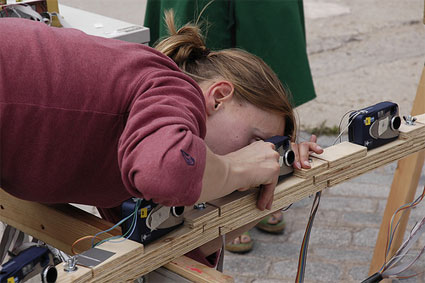 Image courtesy of Emanuel from tagr.tv
Image courtesy of Emanuel from tagr.tv
This system is a prototype for a portable image recording system based on cheap, disposable multiple cameras positioned along a path. Controlled by a microcontroller, each camera can be assigned an individual time delay.
The aim of the project was to create an affordable platform which enable all kinds of temporal-spatial experimentation. Their first prototype for example, tried to re-conceive or visualize a spatial perception which expands the body’s point of view in space. Check out the videos on the project website to get a clearer idea of what the project is about.
What was the inspiration the Immodesty project? How did you come up with that idea?
My background is in animation and video, and I’ve always been interested in making videos whose structure is manipulated at a very basic level, frame by frame, and that say something about our perception of time or space or point of view. These three elements are normally linked as the camera simulates our experience of visual perception. If we disassociate them, we can step outside this experience and maybe ‘cheat’ the laws of physics. There is something magical about seeing physical reality from a point of view that this reality precludes.
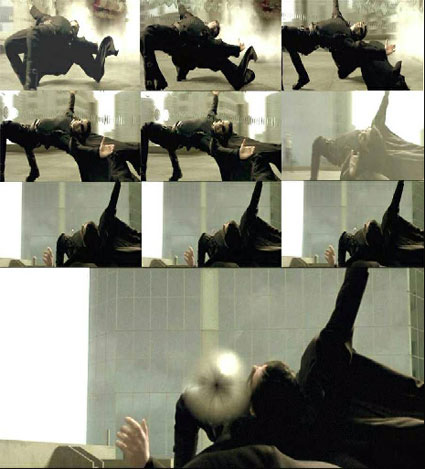
Screenshots from The Matrix (image the raw feed)
The kinds of videos I wanted to make would call for the multi-lens camera set-ups (which do exist — and which were made famous by the bullet time effect from Matrix — but are very out of financial reach for an independent artist). So when I had an idea for a video that would require a fast and long vertical movement of the camera, Interactivos? call came along for ‘Vision Play’ projects. During the workshop I wanted to create a reconfigurable recording system, which could be used to create many different kinds of content, a tool for artists to experiment with, as well as to demonstrate one kind of recording paired with one kind of display. Since I’ve been interested in the viewer’s interaction with an image and in the bodily experience of space, I ended up going with recording moments in time from multiple points of view, and building narrative with them. The narrative would unfold as the viewer explored these moments by moving through space. The change in perspective gives the viewer new information about the scene she’s watching. It is a similar experience as when you walk by an open door and only see a fragment of the scene at a time. Your movement reveals the space and the story. When you come back to the doorway the scene is different, the story has advanced. In the installation the viewer would be able to approach the story from either direction, and once she’s seen the entire ‘moment’, a new one will be loaded that shows another moment in the same story.
I think this is a nice metaphor for the scope of our attention, always moving from detail to detail to sequence them together in a sense-making pattern.
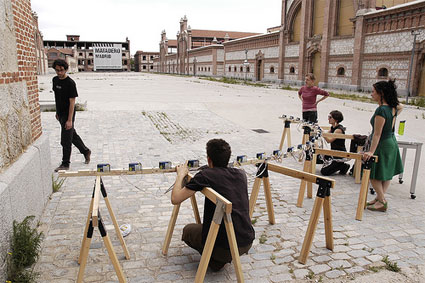 height=”283″ />
height=”283″ />
Image courtesy of Emanuel from tagr.tv
Immodesty seems to be very complex from the technology point of view. Which kind of challenge did you encounter while developing it and how did you overcome them? Did the difficulties make you modify any aspect of the project?
In a way the technology to make it possible existed already when Eadweard Muybridge was arranging his cameras sequentially along the path and triggering the shutters — the complex part is turning it into a portable, modular system that’s affordable and easy to experiment with. For a while the biggest challenge to creating a system like this was the expense of technology, but today the prices of cameras are dropping, it’s conceivable to use lots of them for one project, and it is possible to imagine it as a tool for experimentation. The cameras are also getting smaller and lighter, which make it possible to make a portable rig and to manipulate and position the cameras more freely.
This project posed many challenges, for example designing and building a modular reconfigurable rig, that would at the same time provide the rigidity and near-perfect alignment for the cameras. We ended up creating a wooden module for each camera that could be angled independently in the horizontal plane and that still allowed the cameras to be tilted and adjusted by hand. Most challenges were overcome after a lot of head-scratching thanks to the great help of the awesome collaborators and instructors at the workshop. One problem however that we couldn’t go around was the inconsistency in the time delay between the triggering of the shutter and the camera capturing an image, which made impossible the precision necessary for achieving some nice time effects. For the next version of the project I’m planning to use different cameras, hopefully solving this problem. This time we used the Dakota disposable digital cameras, the least expensive option, and which I liked because of utilizing the hack developed for these cameras when they came out, though it might have proved to be more of a trouble than benefit.
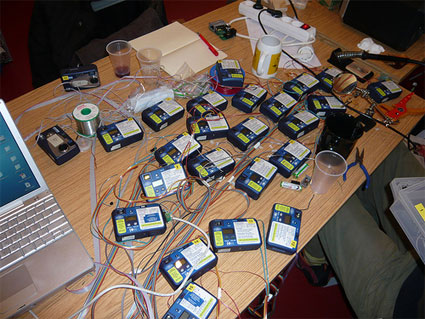 Image courtesy of Emanuel from tagr.tv
Image courtesy of Emanuel from tagr.tv
Creating the interactive display also posed some challenges. We had barely any time to put the installation together and could barely give enough consideration to the spatial arrangement, and to making sure that the size of the image and change in the projection felt correct in relationship to the viewer’s movement.
The project plays with spatio- temporal situations. Can you describe the kind of experimentation the multi camera system can give life to? Did any application emerge over the course of the development that you had not thought about before?
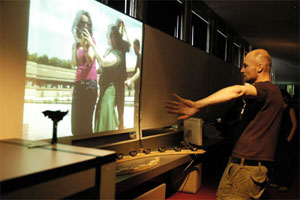 I think it would be interesting to record things impossible to experience physically: extremely slowed-down time flow while the movement in space is fast, or camera movement in the ‘frozen instant’ combined with a display in a ‘augmented reality’ system. For example I would like to create a spherical rig to record spherical video (the cameras would all be triggered at the same time and the images stitched into a large spherical map) that could be explored in a custom interactive display. It could be used for exploring movement and perception not possible through our physical bodies: for example my initial idea to create the vertical camera movement, in a video shot from a point of view of someone who is jumping higher and higher, way beyond human capabilities. I can also imagine it being used as a ‘wearable’ recording system, lightweight enough that it could be carried around while recording.
I think it would be interesting to record things impossible to experience physically: extremely slowed-down time flow while the movement in space is fast, or camera movement in the ‘frozen instant’ combined with a display in a ‘augmented reality’ system. For example I would like to create a spherical rig to record spherical video (the cameras would all be triggered at the same time and the images stitched into a large spherical map) that could be explored in a custom interactive display. It could be used for exploring movement and perception not possible through our physical bodies: for example my initial idea to create the vertical camera movement, in a video shot from a point of view of someone who is jumping higher and higher, way beyond human capabilities. I can also imagine it being used as a ‘wearable’ recording system, lightweight enough that it could be carried around while recording.
Many people brought many different ideas to this project — from an architectural point of view it could be used to create ‘virtual spaces’ or ‘expanded screen’. Someone working with stereo imagery, like Alvaro, would be interested in creating stereo videos using parallel camera paths. It could serve as a kind of a ‘total view’ mirror.
Several ideas came up also for using it interactively and hopefully we’ll be making some of them real soon!
Do you plan to develop the project any further?
Yes, definitely. What we developed at Interactivos? was a very imperfect prototype, which demonstrated only one simple application. There is definitely plenty of room for improvement and for taking it into many different directions. I’m planning to use different cameras that will allow more flexibility: automatic download or even real time image capture, perhaps video recording capability, etc. Hopefully we’ll be able to bring to life some of the ideas that came up during Interactivos? and I’ll be able to create more videos and installations.
I’m definitely open to any ideas people might have for using it, and once we have our second prototype that’s a little more stable it would be great to make it available for different kinds of projects.
Thanks Karolina!
